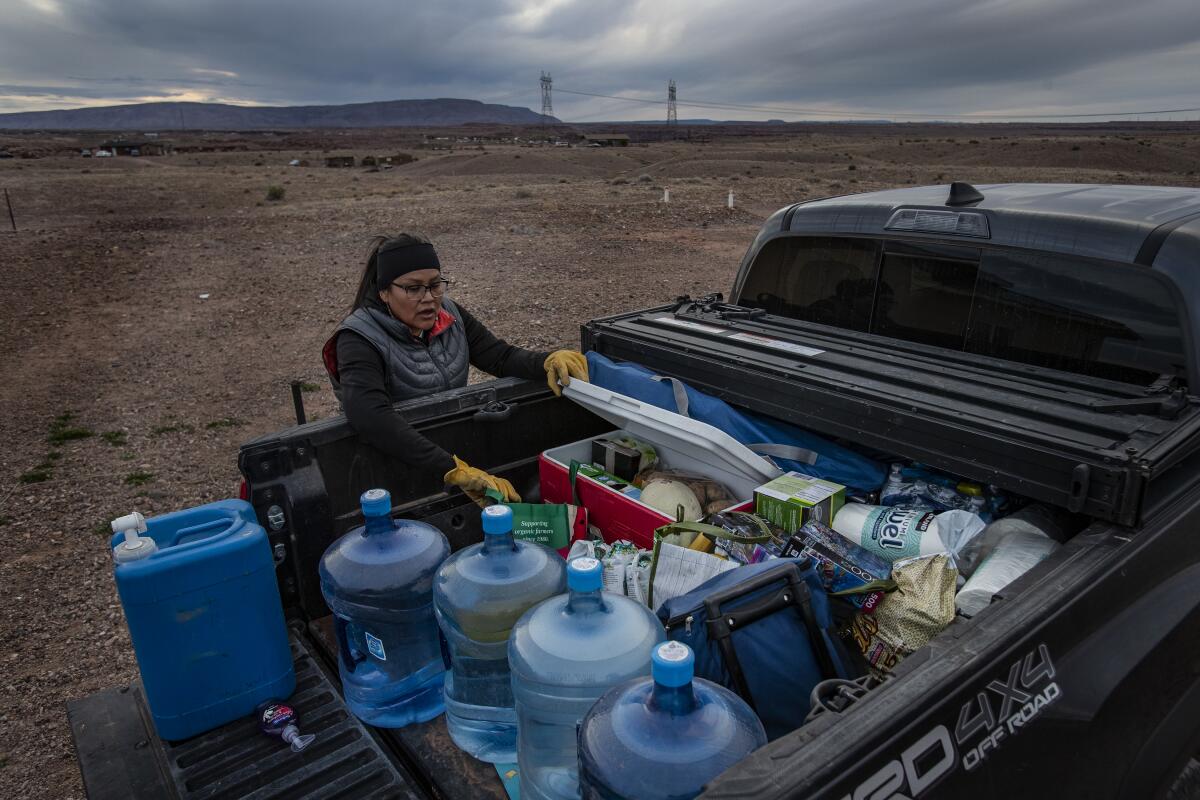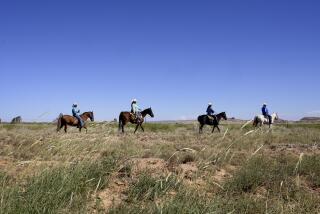On Native American reservations, the push for more clean water and sanitation

- Share via
When the clean water system failed at the Warm Springs Reservation in Oregon this week, thousands of residents relied on members of nearby communities to come to the reservation’s aid with bottled water.
It was not the first time clean water had become difficult to find at Warm Springs, two hours southeast of Portland, or at many other Native American reservations across the United States.
The nonprofit U.S. Water Alliance says 58 out of every 1,000 Native American households don’t have access to indoor plumbing. Many Native Americans don’t have access to clean water because of faulty, outdated or nonexistent pipes or water systems or other problems that result in residents resorting to bottled water or boiled water, which kills viruses, bacteria and parasites.
Oregon Sen. Ron Wyden introduced a bill in February aimed at funding clean drinking water and sanitation facilities in tribal communities. The bill, whose future remains uncertain, calls for the Environmental Protection Agency to connect, expand or repair existing public water systems on reservations and would cost about $150 million between 2021 and 2026.
“Boil-water notices and crumbling pipes are not acceptable,” the Democrat said during Deb Haaland’s nomination hearing for the secretary of the Interior. “Congress must do more to bring urgently needed resources to build sustainable tribal water infrastructure that has been neglected for far too long.”
A brief history of reservation sanitation facility improvements
About 130,150 out of 409,535 homes of Native Americans that the government organization Indian Health Service, or IHS, surveyed most recently needed sanitation facility improvements involving water, sewer or solid waste systems at the end of fiscal year 2018. The costs to improve these systems are an estimated $2.67 billion, according to the IHS.
In the 1960s, the federal government heavily funded sanitation programs for tribes after the American public grew increasingly aware of reservation living conditions. The Sanitation Facilities Construction Act, passed in 1959, led to a sharp decrease in gastrointestinal and infectious respiratory disease in both Native American infants and white infants who lived near reservations, according to a Journal of Public Economics study.
According to the U.S. Water Alliance, Native American households are 19 times more likely than white households to lack indoor plumbing. Black and Latino households are twice as likely as whites to lack indoor plumbing.
Federal funding for reservations is not meeting needs, said Randall Akee, a professor at UCLA’s Department of Public Policy and American Indian Studies and chair of the America Indian Studies Interdepartmental Program.
“It’s just woefully underfunded at the federal level, and tribes for a long, long time have not had the resources to fully develop these resources themselves,” he said. “And frankly, it’s a responsibility of the federal government. A trust responsibility of treaties and hundreds of years of commitments. There has been a failure to fully live up to those commitments.”
Tribes across the U.S. struggle with access to clean water
The Hopi tribe in Arizona has up to three times the amount of arsenic in its water than the EPA says is safe to drink. Many Native households in rural Alaska use a five-gallon bucket as a toilet because they don’t have running water. And the Navajo Nation, the biggest reservation in the U.S., faces a diabetes crisis because soda is more accessible and cheaper than clean drinking water.
Bidtah Becker is a member of the Navajo Nation, which spans across northeastern Arizona, southeastern Utah and northwestern New Mexico. She co-led a project and report on access to clean water for tribes in the Colorado River Basin, and has studied, and seen firsthand, how a lack of access to clean water affects her own community and other tribes. She estimates 30% to 40% of homes on the Navajo Nation lack piped water.
The federal Centers for Disease Control and Prevention and the Alaska Native Tribal Health Consortium, known as ANTHC, found links between low water service and respiratory infections. Studies from the CDC, IHS and ANTHC have also found links between a lack of clean water access to skin and gastric infections.
“The other thing that people often don’t think of with access to clean water is that it affects the economics of your community,” Becker said. “If you don’t have pipes to go to homes; you don’t have pipes to go to laundromats, or gas stations, or stores. Clean water is integral to creating a healthy economy.”
The cost of clean water
Almost one-quarter of Native Americans lived below the poverty level in 2019, and fixing or building water infrastructure isn’t cheap, easy or quick.
IHS determined that there were 130,153 homes needing sanitation improvements in Native American communities at the end of fiscal year 2018, and identified 1,837 community-wide projects to assist these homes. The agency’s projects aim to bring sanitation systems to a level that comply with water supply and pollution control laws and only need routine maintenance.
About 28% of these projects are considered “infeasible” by the government, because they’re too expensive. IHS estimates the cost of all feasible projects across the country to be $985 million.
The cost to bring sanitation to this level in Alaska was higher than the cost of every other community combined in the IHS report, at nearly $1.4 billion (including feasible and infeasible projects). With 229 tribes located in the state, Alaska is home to two-thirds of the nation’s federally recognized tribes. Almost 16% of Alaska’s population is American Indian or Alaska Native.
Jackie Qataliña Schaeffer is the community development manager for the ANTHC’s Division of Environmental Health and Engineering. Her role at the nonprofit health organization is to work with rural Alaskan tribes, helping them access water and sanitation services.
Communities that don’t have those services typically have access to a central watering point consisting of a hose connected to a building that provides showers, utility sinks and sometimes commercial washers and dryers.
Residents can collect clean drinking water at the watering point, she said. They then haul the water by ATV, snowmobile or hand to their homes and store it there. They either use an outhouse or a “honey bucket,” a five-gallon bucket with a lid, as a toilet.
Because water is so inaccessible, the average rural Alaskan without piped water only uses three gallons of water a day for things such as bathing, drinking and cooking; the average American uses 156 gallons a day.
Providing rural villages with water and sanitation systems is more difficult in Alaska than in the mainland U.S.
“In Alaska, rural is not just away from a city,” Qataliña Schaeffer said. “Rural is disconnected by any road systems. The only access to these communities is via small aircraft.”
The average rural Alaskan village has a population of 400 to 500 people. It costs $40 million to $60 million to implement a community-wide water and sanitation system due to all the logistical factors. And while the infrastructure itself is often funded by the government, the burden of operation and maintenance costs falls on the community — a burden the communities often cannot afford.
Rebuilding Warm Springs’ water system, and relying on community support to get by
Dan Martinez, emergency manager of the Warm Springs reservation, said the entire water system in Warm Springs needs to be overhauled at a cost of about $40 million. And while the federal and state governments do provide emergency funds to the reservation, they often only cover the costs of quick fixes to a water system that ultimately needs to be rebuilt from the ground up.
While the reservation works toward a long-term solution for its water issues, Warm Springs relies on its neighbors to help when the pipes fail.
“We rely on donated water from outside sources, which has been something that’s happening on a daily basis,” Martinez said. “We rely not so much on the government, but on our neighbors and religious groups and donations from outside sources to give out drinking water.”
Gilbert Brown, who grew up on the north end of the reservation and now lives in Portland, helps haul water donations from a Portland coffee shop down to Warm Springs. This isn’t his first time.
“Last year, the pipes kept breaking, and [the reservation] kept going on boil notices,” he said. “People had to come bring water, and I was asked to help. And here we are again.”
More to Read
Sign up for Essential California
The most important California stories and recommendations in your inbox every morning.
You may occasionally receive promotional content from the Los Angeles Times.











